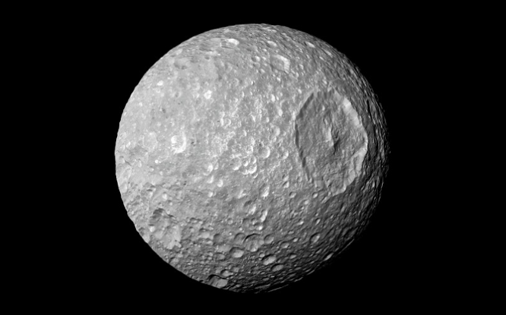Saturn’s moon ‘Mimas’ may have subsurface sea
Say now! Saturn’s moon Mimas may have a subsurface sea? OUR OWN FUCKING SOLAR SYSTEM IS RIFE WITH INTRIGUE. Mark that shit down. Oh, the Kupier Belt, boring? Oh, the Oort Cloud, boring? Oh Jupiter, big whup?! YOU DON’T EVEN FUCKING KNOW. (Also, just ignore all qualifiers in the article. Like “probably” and “might” and especially the “more likely” — they will harsh your excitement.)
New Scientist:
There’s more to Mimas than meets the eye. The wobbles of one of Saturn’s smallest moons hint at an unusual make-up below the surface – perhaps even an ocean of water hidden underground.
Mimas isn’t the first of Saturn’s moon to show signs of being soggy. Enceladusspouts plumes of water at its south pole, perhaps seeded by a subsurface ocean. Saturn’s largest moon, Titan, is known to have rivers and lakes – albeit filled with liquid ethane and methane instead of water. But no one had thought to find fluids on Mimas: it has no geological activity or interior heating, telltale signs of concealed liquids.
“People thought that this was a boring moon,” says Radwan Tajeddine at Cornell University in Ithaca, New York. Most suspected that Mimas was either made up of solid rock, or perhaps a silicate core with an icy shell layered above.
The story changed when Tajeddine and his team took a closer look at photographs taken by NASA’s Cassini spacecraft, which has been orbiting the ringed planet since 2005. By comparing the location of Mimas’s craters from image to image, they found that its rotation was slightly irregular: it was wobbling about twice as much as would be expected. This suggests that the moon has a more exotic interior than previously expected.
A global ocean around 30 kilometres below the surface could explain the unusual swaying. The idea is akin to spinning a raw egg and a hard-boiled egg on a table, explains Tajeddine: the raw egg will spin more slowly and unevenly as its liquid insides slosh around.
Such an ocean on Mimas would be a surprise, as most of the core heat needed to keep water liquid would probably be lost through the moon’s icy shell. But friction inside the moon caused by Saturn’s gravity and Mimas’s extremely eccentric orbit might melt the ice and preserve the ocean.
Another possibility is that Mimas’s silicate core is elongated, shaped more like a rugby ball than a sphere. If so, this means Mimas and some of its fellow moons probably formed in the rings of Saturn, rather than alongside the planets in the early days of the solar system. When small chunks of rock clumped together in the rings to become moons, they could have formed an odd-shaped core that was then fossilised inside a sheet of ice.
A fresh Cassini fly-by could help determine which theory is right. The gravity of any anomalies inside the moon – like an elongated core – would disturb the craft’s trajectory as it passed by. In addition, scientists could measure the surface temperature of Mimas for signs of watery heating inside.
An ocean discovery would be exciting, but a bumpy interior is probably more likely, says Francis Nimmo at the University of California, Santa Cruz. “It’s really hard to understand how an ocean could survive for billions of years inside something as small as Mimas.”
Shh. Let us have this.




